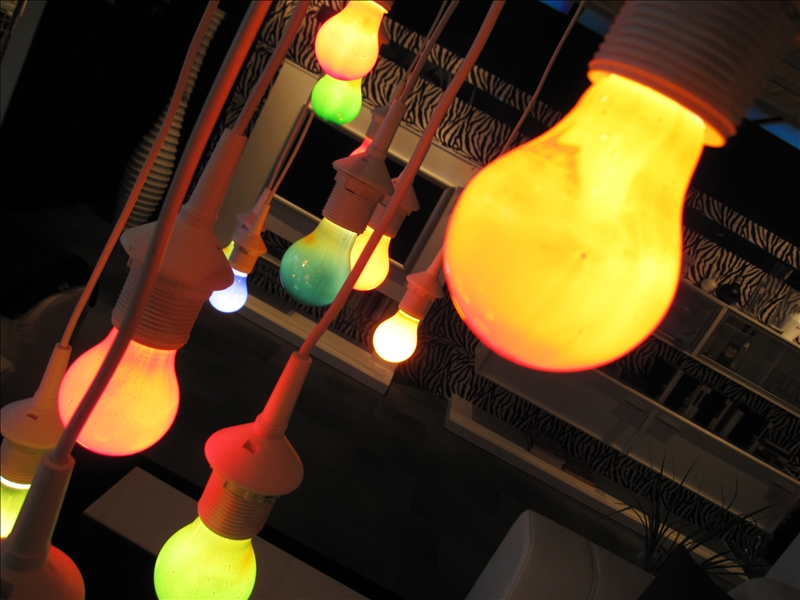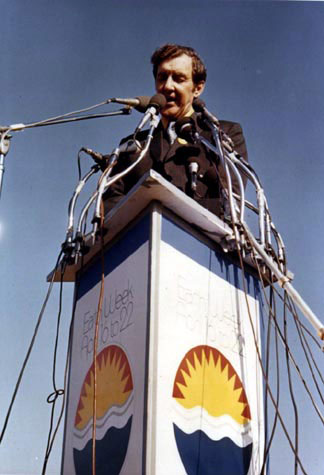When I was growing up, my father was always trying to save energy and money. We were a big family and used a lot of electricity, heat and water. He would constantly scold me and my siblings for leaving on the lights, taking too long in the shower or using up all the hot water.
To this day, when I turn off the lights in my own house, I think of my father.
It’s a simple thing, turning off lights when you don’t need them, but if we all thought to do it, our actions could have a huge impact, not only on our wallets, but also on the environment.
Did you know that nearly half of all greenhouse gas emissions in the United States are generated from the energy we use to power our homes and cars?
That statement comes from the Earth Day Network, which among other things, sponsors Earth Day.
Protecting our environment
Forty-five years ago, on April 22, 1970, the first Earth Day was marked by about 20 million Americans, following a week-long celebration. Maine’s Senator Ed Muskie was invited to be the key note speaker on Earth Day in Fairmount Park, Philadelphia. At the time, he was chairman of the Senate Subcommittee on Air and Water Pollution and played a key role in passage of the Clean Air Act. Muskie is considered by some to be the “father of the modern environmental movement.”
A few months after the first Earth Day in 1970, Congress authorized the creation of the Environmental Protection Agency and charged it with overseeing and enforcing new laws, such as the Clean Air, Clean Water and Endangered Species Acts.
Five years ago, the Aspen Group, an energy and environment program, summarized 10 ways the EPA has strengthened America’s environment.
- Banning widespread use of DDT
- Removing the acid from rain
- Rethinking waste as materials
- Removing lead from gasoline and from the air
- Clearing secondhand smoke
- Vehicle efficiency and emissions controls
- A cleaner environment for all
- Controlling toxic substances
- Cleaner water
- Public information and community right to know
[Tweet “Every little “act of green” protects the environment”]
A Billion Acts of Green®
We can breathe easier now, but we still face formidable challenges. In particular, climate change. Over the past 45 years, the earth has been warming at a faster pace than previous decades. Scientists say the main cause is the rising emissions of greenhouse gases.
In 2010, the Earth Day Network launched a campaign called A Billion Acts of Green®. The goal was to get individuals, organizations, businesses and governments to register actions they were taking to protect the environment in time for the United Nations Conference on Sustainable Development in June 2012. The goal was reached on April 22, 2012 — Earth Day.
The campaign was such a success, the number of “acts of green” was increased to two billion. Are you doing something to protect the environment? Even turning off those lights or taking shorter showers counts. You can register your actions and find out what else you could be doing on the Earth Day website.
I’ve also compiled a list of tips from the Earth Day Network that will help you save energy (and money).
[Tweet “Did you know? Letting your grass grow saves energy.”]
7 ways to honor the Earth every day
- Clean the dryer vent. If your clothes take more than an hour to dry, check the external exhaust vent to your dryer. It could be full of lint, particularly if there are any bends in the tubing. Vacuum out the tubing to keep the vent clean. Blocked dryer vents can cause a fire, so save energy and be safe with a quick vacuum.
- Change your settings. Consider changing your thermostat settings for energy savings. In the winter, set the indoor temperature to 70 degrees or less. In the summer aim for 75 degrees or more. Every extra degree will make a difference on your utility bill.
- Lower your water heater. Often manufacturers set the water heater temperature to 140°F, which is hot enough to scald someone and corrode the pipes. Lower your water heater temperature to 120°F, and test it by running your kitchen faucet at its hottest setting over a thermometer.
- Use timers on electronics. Some electrical devices are only used for a few hours a day, but run 24/7 if left unchecked. Hot water recirculation pumps, outdoor fountains, and electrically warmed floors can all be run on timers. If you have these items, adding timers can be a big energy saver.
- Take shorter showers. The average American takes a 7-minute shower. If you linger in the shower for 20 minutes each day, you’ll use an extra 10,000 gallons of water each year! Use a timer to get on track.
- Replace your shower head. Since 1994 all shower heads sold use 2.5 gallons per minute (gpm) or less. The most efficient models use 1 – 1.5 gpm. If you have an older shower head (pre-1994), your hot water savings will cover the cost of a new shower head within a year.
- Grow longer grass. Tall blades of grass shade soil and roots, reducing water evaporation. A tall lawn needs less water. So set the lawn mower blade cut grass at two to three inches tall. Keep your grass long, mow less often and save water.
Want more tips? I’ve got some!
- Replace halogen bulbs. Halogen bulbs use 10 times more electricity than LED bulbs, and standing halogen lamps have been prohibited due to fire dangers. For large and immediate energy savings, replace your halogen bulbs. There are plenty of great LEDs that will fit right into your fixture.
- Get an energy audit. An energy audit will take a few hours, testing for air leaks, duct leaks, and proper air flow around your water heater and furnace. The auditor will point out the areas where home upgrades can save energy, and what might need replacing first.
- Change the furnace filter. A dirty furnace filter blocks the airflow through your heating system, making the equipment work harder. This shortens equipment life. Don’t worry about “quality” filters – the cheap options work just as well!
- Don’t heat an empty house. Want to come home to a warm, cozy home in the winter? Program the thermostat so your heat comes on 20 minutes before you arrive. Heating a home the whole time you’re away wastes a lot of money.
- Add drapes and rugs. During winter months, windows and floors can feel cold and drafty. Use drapes and rugs to remove these cold spots and save up to 25% on your heating bill. Studies show that thickness (from the carpet or the under-cushion) is more important than the type of material.
- Unplug where possible. Take a walk through your house and unplug items bought before 2008 that are not frequently used. Many older electronics and small appliances draw energy 24/7, but after 2008, products changed and the “always on” load became small. Get the easy savings from unplugging!
- Power down. If you have a desktop computer, power down the monitor and put the CPU to sleep if you won’t be using it for an extended period of time. A good rule of thumb is to use sleep mode if you’ll be away for longer than 20 minutes, and shut down completely when you will be away for longer than 2 hours.
- Weatherize your home. Weatherization is all about reducing the air leaks around your home to make it more comfortable and energy-efficient. Some air leaks are best left to professionals, but a good weekend project is to use a caulk gun and seal the air leaks you can find.
- Turn off the lights. Take a tour of the house at 8 or 9 pm to turn off those unneeded lights. Lighting accounts for 20% of the energy costs in most homes, so this small action adds up to real savings over the course of a year.
- Wash in cold water. Modern detergents are formulated to get the dirt and oils out in cold water, and are gentler on colors and fibers. Cold water washing saves energy and helps your clothes stay bright and fresh. If you do 3 – 4 loads of wash per week, you’ll see the difference on your utility bill.
- Get a hose nozzle. Next time you water your garden, use a hose nozzle. The average garden hose uses 10-16 gallons of water per minute! Avoid waste by shutting of the water when it’s not needed. A hose nozzle makes this easy.
- Use mulch. Mulch (bark chips, decaying leaves, and other garden compost) can reduce water evaporation in the soil. Put a two to four-inch layer around your plants to keep the weeds out and the water in. Your plants will thrive with this layer of protection.
- Install a faucet aerator. Faucet aerators save water by restricting flow, but do it so politely, you won’t even notice. Aerators diffuse the water stream, giving the user a sense of a full run rate. Most standard faucets run at 3 to 5 gallons per minute, and an aerator can reduce this to 1 to 4 gallons per minute. Bathroom and kitchen aerators are easy to install, effective, and a cheap way to save water.
Earth Day 2015
The theme of this year’s Earth Day (April 22) is It’s Our Turn to Lead™
On the Earth Day website, it reads:
“Let this be the year in which economic growth and sustainability join hands. The year in which citizens and organizations divest from fossil fuels and put their money into clean energy solutions.”
[Tweet “What are you doing to protect the environment?”]
What tips do you have to share? Please let us know what you are doing to make a difference. Inspire us to do the same.




Leave A Comment